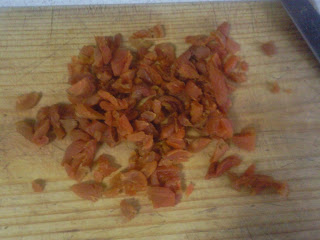So as if my baking arms hadn't had enough of a workout this week, the Christmas baking frenzy has continued; this round includes a double batch of panforte. If you thought after the Christmas cake I'd opt for something a little lighter, a littler easier, think again - this panforte was such a formidable creation it broke my favourite wooden spoon in the stirring.
I decided to make panforte for three reasons. One, I wanted something that keeps and is a little more special than, say, potato salad, to give to people like my step-mother Anne's family, and Leith's family. Two, I wanted to have something sweet in the house as we are having a casual lunch with some Christmas orphans, at least one of whom is vegan, so I needed something involving no diary and no eggs. Three, it's super yummy and in my mind at least, a little Christmassy.
At first I thought I'd make four - one for Dad and Anne, one for the Thomas's, one to take to Mum's and one for us here at home. Then I quickly realised I couldn't be bothered, and it is such a rich cake, and eaten in such small quantities, that I could probably get away with making two and presenting half each to various people. So the recipe I've provided below is for a single cake, but the quantities shown in my pics are double that which you'd normally make. I did my usual food-obsessive ritual of scouring the internet for recipes until I found one I liked the look of, and then changing that one a bit anyway. This recipe is adapted from trusted website taste.com.
Ingredients:
- Melted butter, to grease
- 100g whole blanched almonds
- 100g whole hazelnuts
- 80g coarsely chopped dessert figs
- 40g coarsely chopped dried apricots
- 40g coarsely chopped dried cranberries
- 40g mixed peel
- 100g (2/3 cup) plain flour
- 2 tbs cocoa powder
- 1 tsp ground cinnamon
- 1/2 tsp ground nutmeg
- 1/4 tsp ground cardamom
- 1/4 tsp ground cloves
- shake of chilli powder
- 75g good-quality dark cooking chocolate
- 125ml (1/2 cup) honey
- 55g (1/4 cup) caster sugar
- Icing sugar, to dust
Set the oven to 180 C then prepare a 20cm pan by lining it with baking paper, then brushing it with melted butter.
Then place all your nuts in baking trays, and roast them in the hot oven for 8 minutes. Once they're in the oven, chop your fruits and put them in a large mixing bowl. Remove the nuts from the oven and place the hazlenuts on a clean teatowel, then rub them vigorously to remove as much of the skins as you can (this may take a few minutes). Add them to the fruit mix and mix thoroughly. At this point, turn the oven down to 170 C.
Sift the flour, spices and cocoa over the fruit and nut mixture and mix through evenly.
Roughly hew at your cooking chocolate and put it in a smallish saucepan with the sugar and honey*. Place them over heat, stirring constantly, until the sugar is dissolved and chocolate all melted. Then turn the heat to high and bring to the boil. Once boiling, turn the heat down low and leave to simmer for two minutes without stirring.
Then pour over the dry mix and stir it through. The recipe told me to work as quickly as possible, and I was all "yeah yeah, how long can it take", but this instruction should be taken seriously indeed! Within seconds of removing from the heat the mixture will begin to harden to a spoon breaking consistency, and all you will be able to do is grab a second, sturdier spoon, and continue to mix. Pouring it into the baking pan also proved to involve a lot of grunting and thrusting. The best tip I can relay is to have a clean, largish square of baking paper to hand to press the mix down into the pan evenly with - without this advice I would have struggled to get it to even touch the sides. Then lick the large globules stuck to your spoon, and place in the oven for 30 minutes.
Remove from the oven and allow to cool for several hours before you attempt to remove it from the pan. Serve dusted in icing sugar, in thin wedges with coffee or tea, or maybe a cognac.
*I firmly believe that using good quality chocolate and cocoa will make a noticeable difference to the final richness and smoothness of a cake such as this. I used Henry Langdon Dutch process cocoa, and Coco Black cooking chocolate (that I bought in a one kilo slab a while back...best. investment. ever)




















































